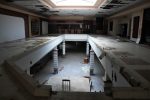CMBS. Not exactly a familiar acronym to most of us. It stands for collateralized mortgage-backed securities, which refers to the repackaging of the underlying mortgages beneath hotels, shopping malls, and other large properties to create securities which are then sold to investors, offering a way to finance debt beyond the relative safety of plain vanilla mortgage loans.
Hawaii hotels are sitting on billions of dollars of CMBS which are subject to debt service payments and eventual repayment of the principal amounts. But the current lockdown of Hawaii’s tourism industry could leave many facing difficulties making required payments.
Back in early March, prognosticators were suggesting Hawaii’s visitor industry could see revenue declines of 15-35% this year due to the COVID-19 pandemic. Under those scenarios, Hawaii’s tourism-based industry was rated likely to weather the financial storm, with perhaps a couple of shaky properties.
But a virtually total shutdown of the entire industry for an extended period of time, with no clear path to full reopening, doesn’t just mean a high level of unemployment among hotel, restaurant, and retail employees.
The danger, of course, is if hotels may be unable to cover their debt service payments and default, especially if Hawaii’s lockdown is prolonged. With revenues down to zero at this time for most Hawaii hotels and resorts, it’s hard to imagine that there isn’t a lot of fear and trembling behind the scenes.
Pacific Business News called attention to the problem in a March 31, 2020 story.
In a March 27 letter addressed to a host of federal regulators, the heads of the American Hotel and Lodging Association and Asian American Hotel Owners Association said the industry’s “unprecedented cash flow crisis” brought on by the COVID-19 pandemic requires a separate financial lifeline as well as special protections from the sector’s legions of lenders and loan servicers….
“Many hotels are unable to pay operating costs and thus debt service,” wrote AHLA President Chip Rogers and AAHOA President Cecil Staton in their letter to the U.S. Treasury, Federal Reserve and Securities and Exchange Commission. “This will cause a snowball effect of foreclosures followed by lenders taking ownership of severely distressed assets with no ability to operate them.”
“Hotels in the Urban Honolulu area owe more than $2.2 billion in outstanding debt, and those in the Kahului-Wailuku-Lahaina MSA has nearly $750 million in outstanding CMBS debt,” PBN reported, pointing to 17 properties in Honolulu and another 7 on Maui with outstanding CMBS debt exposure.
A March 2, 2020 report by the Kroll bond rating agency also assessed the situation in Hawaii.
“Hawaii is home to 18 lodging properties—$4.33 billioin by allocated loan amount (ALA)—that serve as collateral for 17 loans securitized in 25 CMBS transactions. Additionally, there are 28 retail properties, inclusive of mixed-use assets with a significant retail component, collateralizing 28 loans ($2.95 billion) in 30 securitizations.”
Kroll then examined scenarios what would happen under “stress” where hotels were hit with drops of 15%, 25%, and in the worst case considered, 35% declines in business.
The report found only two properties, the Four Seasons Resort Hualalai and Waikiki Beach Marriott Resort & Spa, would not have the cash flow to cover debt obligations under at least the worst case scenario (a 35% decline). But if the same review were done today, it’s unclear whether its conclusions would be so sanguine.
Back in 2017, data published at Trepp.com, which maintains what it says is the largest commercially available database of securitized mortgages, listed two Hawaii resorts as among the five highest valued properties backed by securitized debt transactions.
The Hilton Hawaiian Village was ranked #2 by Trepp with a value of $2.23 billion.
Overall, the borrower’s fees and leasehold interest in Hilton Hawaiian Village anchors $1.275 billion in CMBS debt that is securitized in the single-asset HILT 2016-HHV deal, along with eight other conduit transactions. The fixed-rate mortgage is split into 16 pari-passu A-notes totaling $696.6 million and five B-notes with a combined balance of $578.4 million that were used for the refinancing of an existing $1.255 billion debt package.
And the Four Seasons Resort Maui at Wailea followed at #5 on Trepp’s list. The resort, with an “as-is” appraised value of $910 million (in 2017), “secures $600 million in debt that consists of a $469 million CMBS loan and two mezzanine notes totaling $131 million,” Trepp reported.
With high occupancy rates, these mega-resorts were projected to have little trouble covering their debt payments. However, with zero occupancy for an extended period, many others could be facing cash flow problems.
I’m less than comfortable making sense of the risks ahead as a result this kind of high financial stress. As they say, however, there be dragons.

